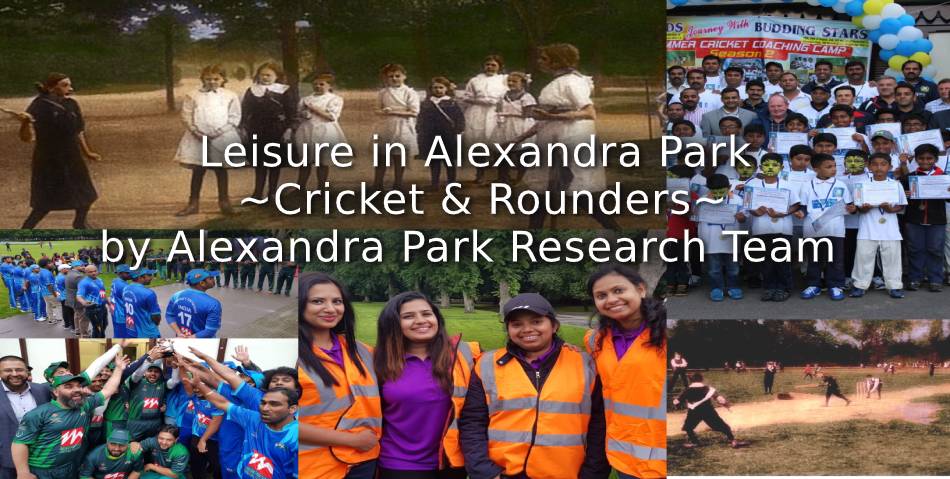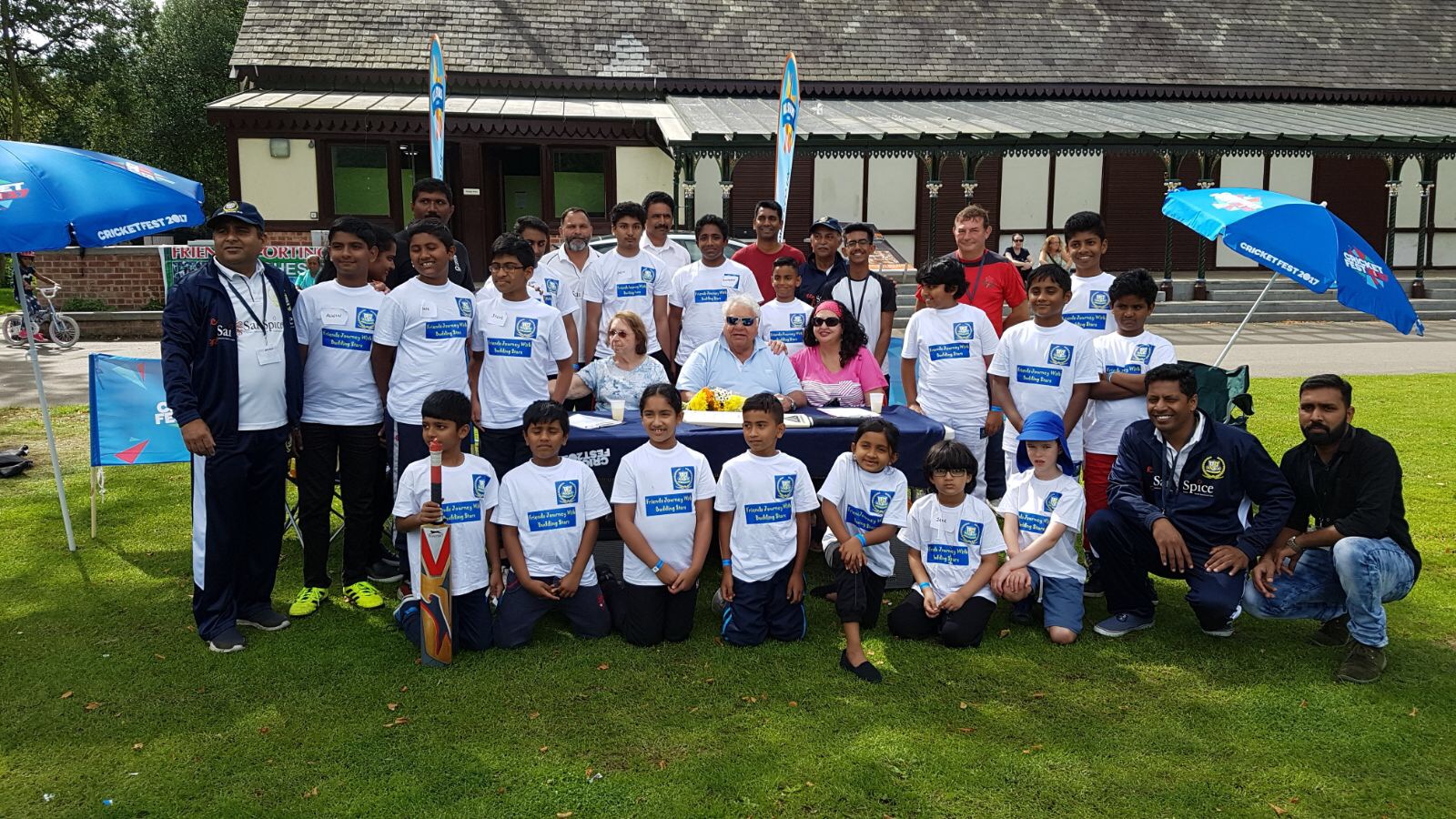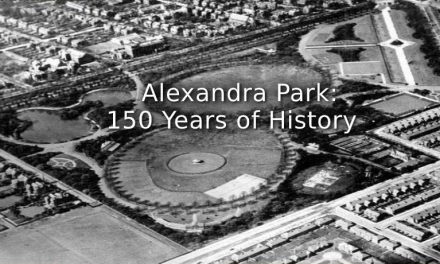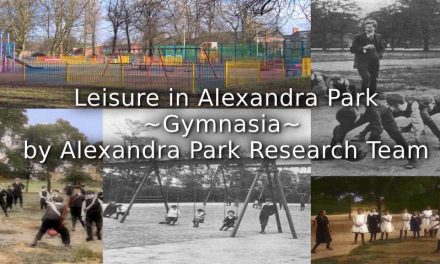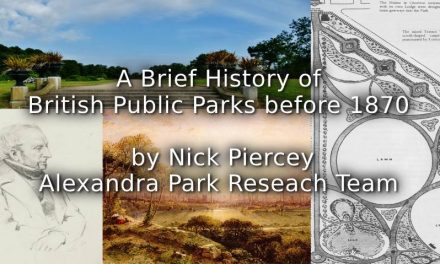Introduction
Despite a lawn for cricket being incorporated into the design of the Alexandra Park in 1869, evidence survives of early cricket in the park. While newspaper reports suggest many matches in the Alexandra Park neighbourhood, that these occurred before the park had been completed, indicates other spaces for cricket may have existed in the area. However, from the last decade of the nineteenth century, the park slowly became a location where local boys would play cricket and girls rounders, despite the frequent prohibition on using the grass at certain times. This trend continued in the early 20th century, as the park became a location for recreational cricket, while more formal games occurred in different parts of the neighbourhood. Finally, in the 21st century, cricket made a formal return to Alexandra Park as it became home to a new generation of teams and players. Here is one story of cricket in the park.
The First Decade: Fallow years.
Whether cricket happened in Alexandra Park in the first decades after its opening is difficult to say with any certainty. While the park included a cricket oval in its plans, the guardians of the park, the Manchester Corporation, often refused permission for matches to be played in South Manchester’s new recreational space. In 1871 and 1872, the corporation issued a blanket ban on playing cricket in the grounds and no mention of the sport occurring in the park is made in the minute books of the Corporation. This, perhaps, masks a more nuanced relationship between the Park and cricket. While the park may not have hosted organised games, the area around it saw many such matches occur. In 1869, a match between Marlborough and St Michael’s Second XI (a team of choristers) was noted as taking place in the Alexandra Park a year before its opening. It seems strange that this could be happening whilst the work of constructing the park was going on around them and suggests that the newly acquired land around the park were fast becoming a leisure hub, even before the park was complete. St Michael’s and Marlborough clubs regularly played in the Alexandra Park neighbourhood, so too did Greenheys Standard and Upper Moss Lane Alliance and there was a politically tinged match between Gladstone’s Liberal’s and Earl Derby’s True Blues. While matches are noted as happening either ‘in’ or ‘at’ Alexandra Park that it had not yet been completed indicates that there was plenty of space, goodwill, or money, for cricket to exist without it. This tantalisingly vague description and the nuances of language opens up the possibility of organised matches taking place in the park in the 1870s, however, the lack of reference to such games or costs involved, suggests that the exact locations will remain a mystery.
However, as Fred Crofton highlighted in a letter to the Manchester Guardian, this rosy picture of cricket in the neighbourhood also needs to be nuanced somewhat. In 1872, Crofton reported that the ‘noble game of cricket has suffered sadly the last few years for want of ground’, adding that many local Hulme clubs had been disbanded and that Manchester had produced few players for the county. This letter reiterates that cricket was likely not played in the park and Crofton suggested that this should change, noting that cricket would both improve the health of players and ‘relive the quiet monotony that now awaits [the park’s] visitors.’ Mr Crofton’s pleas seem to have fallen on deaf ears and matches likely occurred outside the park at other locations. That matches played by Hulme Grammar School or St Bede’s College on their own pitches were sometimes noted as taking place ‘in’ or ‘at’ Alexandra Park, illustrates the difficulty in deciphering the exact locations of matches.
The 1880s: Calls for Cricket increase.
There seems to also be a lack of cricket in the park in the 1880s. A certain ‘J.C.’, hints that cricket remained absent from Alexandra Park in 1883 in a letter to The Manchester Guardian. Highlighting that cricket was part of the original plans of the park, he states that the lawns ‘ought to be used for that purpose’ but that at present it was ‘not much use to the public for the greater part of the year.’ To provide a cricket pitch, according to the reader, would ‘cost very little’. Later in the year, Samuel Falle outlined that a failure to provide such facilities could have dire social consequences in another concerned letter. If the ‘rough lads from our streets are not allowed to spend the exuberance of their spirit’s on cricket and football’ he warned ‘they will do so in vice and crime.’ Like Crofton and J.C. before him, Falle urged the corporation to provide fields in Alexandra Park to do so.
That they did not do so is suggested by correspondents later in the decade and can be linked to wider debates about the role of the park. In June 1887, Mr J. Beattie, proposed a match comprised of two good elevens which would meet with ‘great public favour and interest’. In customary style, the minutes noted that this request was rejected without further elaboration. In the 1880s debates about the role of Alexandra Park began to surface, in particular the fact it was financed by Manchester ratepayers but lay outside the boundaries of the municipality. In 1889, campaigner for open and recreational spaces, Herbert Phillips wrote a letter which was clear in its view. The park, he noted, was a benefit because of its proximity to the city and its ability to attract the ‘well-to-do’ to live, but he also sounded some criticism as to the park’s use. It was a shame, he said, that the park could not be used for cricket adding that ‘you see, there ,wide spaces of smooth grass, which at once invite the cricketer and yet mock him, for he is not allowed to play.’ Not everyone was so fulsome in their praise. The parks situation near Moss Side, according to F.L., meant that those working in the centre were paying for a location they could not reach on a workday and owing to an Act of Parliament the sale of the land would be difficult to bring about. However, the correspondent suggested, cricket might be able to supply the answer. Should Alexandra Park be transformed into ‘a huge cricket ground’ it would be of no harm to Moss Side and would cover the costs of the ratepayers or even turn a profit. While such ideas did not come to fruition, debates about the role of the park and its expense continued in the 1890s.
Though cricket was seemingly absent from the park, its cousin, rounders, was not. A match between South Manchester and Widnes-based Simm’s Cross took place ‘at’ Alexandra Park in August 1886, resulting in an 83-85 loss for the Mancunians. While it is not certain this was in the park, a letter from Chas M’Donald to the Manchester Guardian the following month shows that matches were played here. Mr M’Donald reported that the game had been greeted by many spectators who had largely come to hear the band in the park. A seemingly warm report suggested that the game would be both good for the health of the public who had been ‘cooped up in the workshops during the week’ and ‘no more dangerous’ than cricket to onlookers. A concerned letter to the Parks Committee from T. Wilcoxon in 1887, about the use of a hard ball for rounders, seemed to suggest that some were not so convinced.

Girls playing Rounders in Alexandra Park Manchester (1907)
Source: Archive Plus (hand tinting by Michael Stockton)
The 1890s: Hints of Change
Hints that the Alexandra Park had a cricketing past are suggested in newspaper reports and council minutes later in the century. In May 1893, the Manchester Courier and Lancashire General Advertiser reported that cricket had had to be stopped on the lawns, owing to the state of the grass, although this could be reconsidered during the season, should they recover. On the same day, the annual Whitsuntide reports in the Manchester Guardian noted that games would be prohibited ‘in the large open space usually allotted to summer pastimes.’ Committee minutes confirm that a part of the park had been set aside for football and cricket but would be temporarily discontinued. It is clear that, from 1893, space had been set aside for spontaneous games, including cricket and there remains the possibility that such games took place well before this period.
A year later, in June 1894, local Boys Brigade leader, C.E.B. Russel noted that the space in Alexandra Park formerly ‘used by lads under 16 as a cricket ground in the summer months’ was closed. Such records give a glimpse of the park’s cricket past and a hint of its community purpose. By the 1890s, at least, the park was used by young boys from the surrounding area, perhaps at local schools, for either formal or informal matches. The park catered for a recreational need to those who otherwise would have little access to more expensive fields or playing grounds. However, the reports also demonstrated that the use of the park for cricket was not guaranteed and, by the mid-1890s, the state of the grounds often caused a prohibition in play. In 1894, the Parks Committee prohibited play in the month of June and no minutes suggest this was reversed in that year. In 1895, a letter to the Manchester Evening News both highlighted the lack of cricket and the problems caused by the park’s location. In response to a call for cricket to be allowed in the park, the correspondent noted that ‘the Corporation can hardly be expected to exert themselves in the interest of the “feather-brained dudes” of Moss Side or of those who decline to contribute towards the maintenance of the park.’ In the same year, it was noted that the Moss Side council itself was trying to find spaces to paly cricket, as it was banned in the park. Perhaps, the Moss Side governors were also regretting the location of the park as it made finding space for them to control more difficult. In 1896, Herbert Phillips presented a report which indicated that cricket was still prohibited in the park. By 1898, cricket had returned to the park as ‘A Daily Visitor’ noted in The Manchester Guardian. Although he suggested that the park was ‘deteriorating into a cricket field for children’ this would be fine so long as they stay in the allocated areas. Mindful of the expansion of the population, the next day George A Lawton had a letter published, which indicated that more space was needed; ‘less flowers and more exercise ground’ would both lower the rates and give teenagers somewhere to play.

Boys playing Cricket in Alexandra Park Manchester (1907) –
Source: Archive Plus (hand tinting by Michael Stockton)
The 1900s: A community space for cricket
In the early twentieth century, cricket seems to have become engrained into the fabric of the park through spontaneous games and matches. In 1908, The Manchester Guardian provided a lengthy report on the park, highlighting that it was busy with children in spaces designed for games. Sometimes these spaces were not big enough as ‘little batsmen were hitting out with reckless disregard of the nearness of a neighbouring pitch and mothers with their families who were venturing to picnic in spite of the cold wind had to be constantly alert.’ Similar was on display in 1914, when the Manchester Evening News reported on ‘Holidays at Home’ with photos showing exuberant boys and girls playing rounders and cricket in the park under the gaze of watchful adults; rounders for girls and cricket for boys, indicating the gendered nature of sport and its spaces. By 1920, the concerns at bare earth had seemingly disappeared with ‘cricket balls falling on the sun-baked earth [raising] a cloud of dust that suggested the smoke of a bursting bomb’. Following the end of the First World War, this fitting metaphor suggested much had changed; for one thing, playing cricket had become more important than protecting Alexandra Park’s immaculate grass.
The Return of Cricket
In 2001, The Friends of Alexandra Park was established, with the aim to help Manchester City Council bid for Lottery Heritage Funding to improve what had become a sadly neglected Alexandra Park. This group consisted of local residents and park users. By that stage it was largely perceived as a no-go area by the local communities, being as it was only really regularly used by dog walkers. However, prior to this there were some cricket matches taking place on the north end of the North Oval. An artificial ‘cricket square’ was laid down for local amateur cricket groups to play on, and, especially during the ‘season’ cricket matches would take place first thing in the morning and then around early evening on a regular basis. If walking the dog at 7:30 am, people could always pause to watch various groups enjoying themselves, there are also anecdotal stories that post-shift ‘games’ were played in the Park in the early hours of the summer months, workers such as those from the restaurants in Rushholme or taxi drivers, would appear with their bats as soon as it was light. Where you one of these players? – perhaps you could get in touch to share experiences.
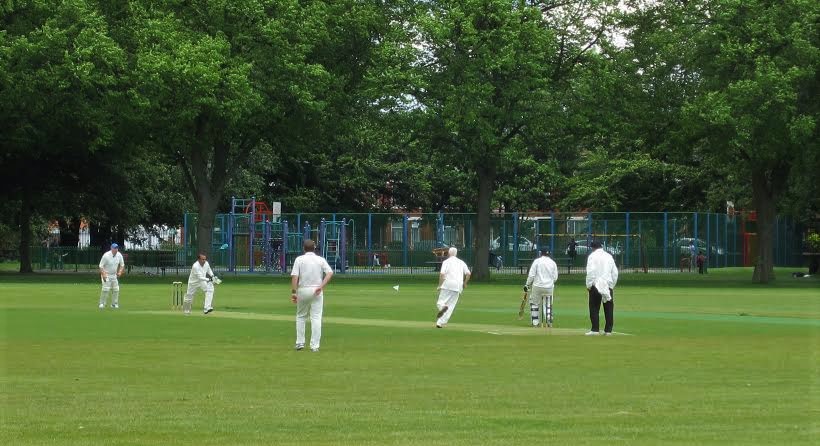
A Game of Cricket (2014)
Image courtesy of Phil Benson-Hannam
This continued during the restoration, and it soon became clear that there was true local enthusiasm and a real need for this greatly used facility to be restored to its former glory. The decision was made to remove the ‘square’ and build a brand-new professional cricket pitch, in its now permanent home, on the Southern Oval, which is currently maintained to English Cricket Board standards.
The City Council submitted its first funding bid to the Heritage Lottery Fund to restore the park with support from the Friends. The whole process of winning Lottery funding took more than ten years, and throughout that time, it did seem as though the Friends Group had to fight for every little improvement or repair to the park, partly because the response to every suggestion, was to wait and see if the bid was going to be successful.
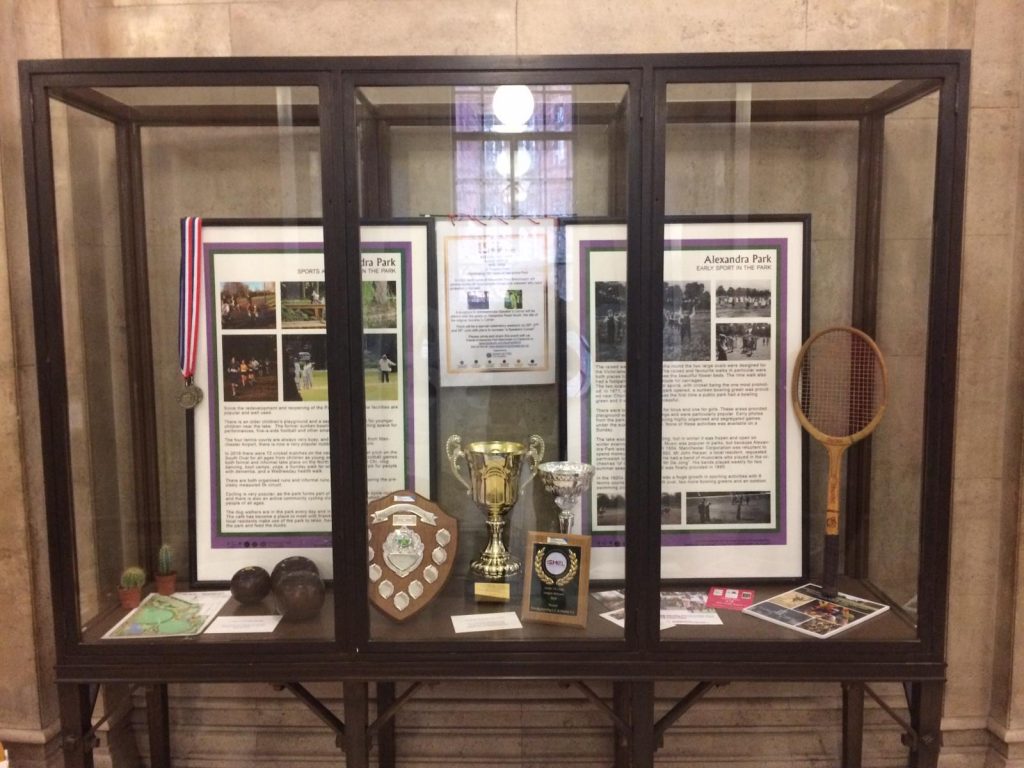
That first Heritage Lottery bid not get past the first of the three stages involved in the bid process. The second bid was therefore prepared which much greater detail, but again rejected, then, finally in November 2012, a third bid was successful. The restoration is a story for elsewhere, but the total bid funds of £4.5 million was made up of £2 million from the Heritage Lottery Fund, matched funded by Manchester City Council, together with investment from the English Cricket Board, the Lawn Tennis Association and Sport England. The cricket pavilion and cricket pitch were brought back to Alexandra Park and now have regular professional teams using it for their match games, including Lancashire Cricket Club’s training groups.
Cricket for all ages, and for men, women, boys and girls, is currently played in the park, and the Friends Group are now asking if the old artificial pitch (on the North Oval) could possibly be reinstated as an informal pitch for anyone to use.
Have you stories or experiences you would like to share to add to the colourful history of cricket or rounders in the Park, then contact us at – Contact@PlayingPasts.co.uk, we would love to hear from you.
Article © Alexandra Park Research Team

